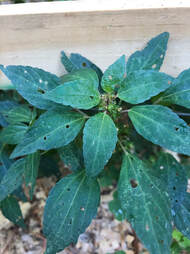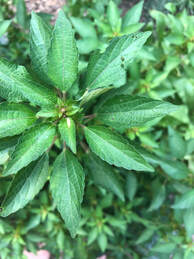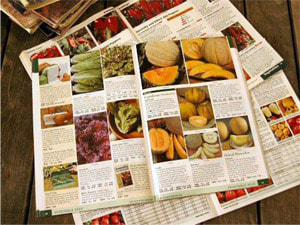 Three seed catalogues arrived in the mail the other day. The garden asleep, and my heart elsewhere for the season, the catalogues come with full intent to awaken hopes and dreams for the growing season to come. I am normally quite bored by seed catalogues--after all, a tomato is a tomato is a tomato--and I have always wondered at how there could possibly be so many pages dedicated to the tomato. Then the cucumber. Then beans, etc. But this time I sat and actually read the section descriptions--and some of the species descriptions, to boot! And I got excited about the potential for certain plants, and could envision how they might fit in the garden this year, if only they behave as described in the catalogue. I wanted to jump up and fetch a marker and circle the ones I obviously need. I wanted to design the perfect three packs of mixed types in order to massage the existing garden design into future--hopefully productive--glory. But seeds or plants? I could get ninety seeds for less than three plants. Or 65 seeds for less than one, depending on species. Would the seeds grow? Do I really need ninety of them? If I pay the bucks for the plants, will they grow better? Will I, in fact, kill them...either by delaying their planting or some future neglect. Seeds seem safer, in general. But I have started seeds indoors, and I have direct sown, and this I have to say about direct sowing, at least in my particular garden (maybe not yours). I direct sow an area in the garden and wait for the babies to come up, and when they do, they don't all look alike. And I don't know which is the actual veggie or flower plant. The preponderance of weeds keeps me guessing, and I am ashamed to say that last year I rid our front planter area of some ornamental perennials in favor of some other spurious characters. Expletive deleted. I am chagrined to note that receiving mid-winter seed catalogues would send me spiraling into a frenzy of doubts and hopes. It's as if I have the proverbial angel on one shoulder and devil on the other: "Hold on, not so fast." "Oh that might be good as a space-saver." "Will it really grow like that?" "That's too many seeds." "That's because they don't all germinate." "One of those would be good...that price is ok." "Too much, too much, too much." "Ooooh. That would be lovely!" … I will leave it to you to determine which one is which. And I have put the catalogue on the shelf for future ruminations. Or perhaps to see who, between those sitting on my shoulders whispering in my ears, wins the debates.
0 Comments
The question remains....what was the outcome of the weed confusion? Were the two plants the same species . . . just looking different in a different micro-climate? 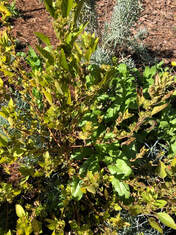 Of course, looking at the pictures side by side now they look totally different, though it was not so clear in the garden. So I waited for them to mature, and, sure enough, the one in the lavender bed grew into something different. Different, but not so very interesting. So whether it was a doppelganger of the award winning weed of the year or not, its differentiation was insufficient for me to have mercy. No flowers, no "fruit"...nothing but imitating Mr. Weed of the Year. So out it went. I found myself apologizing to it. "So sorry, plant, I don't know you." The conclusion of the matter: while you can't always avoid associating with weeds, don't be imitating them. Looking and acting like a weed makes for a weed, no matter what your pedigree. 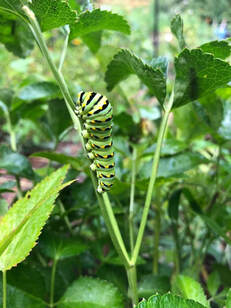 I ran into this beautiful caterpillar in the garden yesterday. I was all excited thinking it might be a monarch, though I knew it was on the wrong greenery for such. However, when I expressed my excitement and invited my husband to come and admire the caterpillar, he turned up his nose, shook his head and said, "Get it outa there! I wouldn't trust any caterpillar!" Unfortunately this put me in remembrance of my initial enthusiasm over the beauty of the Japanese Beetles. What was then so awe-inspiring had quickly become the bane of my garden existence. Or of my garden's existence. So I plucked the branch harboring the caterpillar and placed it in my weed bucket. The caterpillar's life hung in the balance as I researched its pedigree and attitude. Does it decimate garden plants? Does it sting? Who is it, anyway!!?? After a time of research and consultation, we all agreed it is a Black Swallowtail caterpillar, which makes a whole heck-of-a-lot-of sense, considering I've seen so many Black Swallowtail butterflies around lately. Like, duh. But I wasn't so far off with my original ID: these caterpillars do like to mimic monarchs so that potential predators think they are poisonous and will leave them alone. They don't sting, but "sometimes they can eat a lot of carrot greens." So, thumbs up? Thumbs down? I have rescued him from the weed bucket and placed him back near the carrot tops. I can't believe he survived the ordeal. He can have all the carrot tops he wants; he earned them. And I can hardly wait until I see him again in his next life form. Turns out, beauty isn't always deceitful. 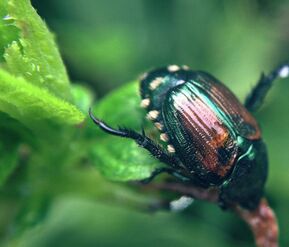 I thought we had snuck by this year; that the yummy plants that attract the Japanese beetles would be spared. Then I saw them, a pair here, a pair there. Not the orgy of colorful shiny creatures I saw the first time they came. And I mean orgy. It seemed every one of them was pair up and stacked up. This year, I thought with relief, there were fewer, and concentrated only on one of their favorite plants. But I was wrong. When I first saw this beetle, I was amazed at the beauty of it--the iridescent metallic colors and the graceful shape. So stunning, reflecting the light into my eyes in shades of turquoise, gold, and rust. And the numbers were amazing. But they are hungry little buggers. And every time I thought they were done and gone I would find another handful, chomping away on my flowering quinces and the cherry tree. This morning, I found evidence of their activity on the peach tree. I have also come to learn that they are producing damage to the lawn area, as their larvae overwinter underground, then chomp on the roots of the grass. And here we were blaming the exuberant dogs that would run and skid, kicking up divots in the meadow. But the large bald spots could not have developed from a divot here and there. I declare the canines innocent and j'acuse the Japanese beetle. It's time for war! These critters can no longer get by in my garden merely by their good looks! 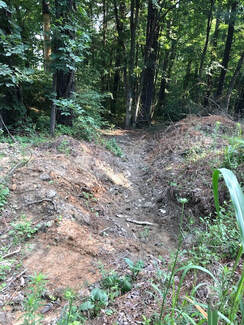 No garden is an island. Most days I walk the neighborhood before my work day, and Dog and I sniff out the changes--visitors, neighbors, and the general state of the environs. Sometimes I have already heard the equipment, heavy or otherwise, altering the landscape, natural or man-made. We are nestled in the woods, all of us here in this neighborhood. It is a forest in transition, having once been farmland, it is now moving from "junk" species to hardwood, and the species in the stories--ground, mid, and upper--actually illustrate the transition, with the tall loblolly pines having been the first to break ground in the farmland. One day they will be no more, and the hardwood will reign supreme. However, according to our local forester, we will not be around to see the day, and there is nothing we can do to speed it up. But I would think there are ways to slow it down, and Dog and I encountered one this spring in several places. The earthmovers had come in, leaving behind a large gash in the earth, overturned greenery, and deep tread marks. It's a disturbance in the forest. Contrary to common assumption and concern, I am one that is ok with that. We the people are a part of the environment, and while we are tasked with being stewards of the land and all that is provided us, we cannot help but have an impact. The only question is where the line between a positive and a negative impact might be. So my response to the disturbance in the forest is more one of curiosity--with these changes what will I witness as time goes on? What transitions will the land go through that I can observe over the next months and years? Will loblollies recolonize? Or can the area go straight to hardwood, passing only through those herbaceous pioneers that we often categorize as weeds. One of the best and hardest things in life is witnessing and taking in change. We can resist, accept or embrace it. Sometimes we just curiously watch it happen. No photo today. I feel a bit wimpy about this topic, but I find I don't know what to think about it. Advice led me to purchase some bird netting to protect my blueberry bushes, as they are coming into fruit. When we came back from a five day trip, I had caught a black snake.
It wasn't just caught. It was wrapped and snagged and twisted. And dead. It must have struggled so valiantly and then, adding insult to injury, something came along and ate off its head. I apologized multiple times as I clipped it out of the deadly trap, losing half my netting and unable to unwind any from the snake's body, my imagination showing me the snake's last moments, the agony and confusion. I know I am anthropomorphizing, but I have to judge this occurrence as dreadful. Sometimes a snake in the garden is innocent. But the garden no longer is. The netting brought death within its borders and tainted my fantasy imagery of the space. Of course, this blog IS about "A relationship with the beautiful, the tough, the frustrating, the fruitful and the barren, dusty places..." Right? I will have to file this under "tough." Tough for me. Toughest for the snake. I have removed all the netting. For some reason most of the blueberries are gone now anyway. Some sort of cosmic recompense, I suppose. Previously mentioned at Kiss the Garden: Delivery of an abundance of plants to plant.
I received a garden catalogue mid-winter that I had never seen before. Wow! You can get a lot of perennials for real cheap! I need perennials. I'm ordering some!! And I did. All told, I think the package contained almost 75 plants, because, gee, you can get 10 of these for $3.95 and 12 of these for $6.00 and I need three packets of those cause I need to mix up the different types, and then there were the freebies and perennial mixes thrown in for good measure. Such a deal! Now, of course, I'm feeling like a slave to my garden. Shockingly these plants came as bare root, so I can't ignore their plight for very long and I need to get them in the ground. I knew I knew I knew they would show up when I had the least amount of time to deal with them: houseguests, final project at the university, End of the Year program for our students, more houseguests, holidays. And weeds weeds weeds to contend with before I can entrust these babies to their new homes. I tried to prepare, and I nagged the catalogue company for insight into delivery date. They couldn't be pinned down and I was ill prepared for when they hit my mailbox. Ironically, the plants were to be delivered on the day of the tornado, but the tracking notice said there was no access to the delivery site. Puhleeeese! A mere tornado will stop you from delivering?! But I was expecting a box. Or boxes. Of plants with green tops and maybe packed with a bit of dirt around their roots. Instead I found a plastic bag stuffed into my mailbox. Ouch (on behalf of the plants.) All told, I'm dealing with my own naivete. About a lot of things. Tornadoes for one. Small print in garden catalogues for another. And that thing about the best laid plans, etc. But mostly I've come face to face with my own personal limitations again. Both in my understanding of this world's system(s), and in my ability to cope with an avalanche of things out of my control. I'm okay with that. It is actually a good place to be. But I'm headed straight out to the garden today. Hours to go before I rest..... Last growing season the garden had the opportunity to go its own way while I was traveling--two separate times over a week each. Each time, the unintended plants (read: "weeds") took advantage and carpeted the ground with their lush green presence. It was bright and lively, but the intended plants were screaming "Help!"
Arriving home from the first trip after dark, the first thing I did was grab a flashlight and inspect the garden. Oh my. What a profusion of laughing, taunting weeds, as far as the flashlight beam might flash. My field biology teacher in high school maintained that there was no such thing as a weed, just a California native. And on the grander scale he is right, since it is only our preferences that determine who belongs in our garden and who doesn't. As for me--let the natives play elsewhere, I'm growing food! But I paused a moment in the garden yesterday and wondered if I could somehow make friends with the unintendeds. After all, they do appear to be winning the battle, and I need to find a different tack. Perhaps they provide a service as a place holder until I can get the preferred plants in. And they do make the garden look green. Isn't that better than the look of scorched earth or gray pavers squashing the life out of the soil? So I'm going to shake hands with and express gratitude to my unintendeds--before I relocate them--and grant them the opportunity thereafter to add their efforts to my compost pile. Yes. I've decided finally to compost them, overcoming my fear of spreading their seeds, for 1) there are so many of them I don't know where else to put them, and 2) I'm determined to compost well enough to overcome weed seeds. I don't know if making friends with these unintended plants is more a matter of attitude, or if there is an action to take, but at the least, I don't want to feel like I'm constantly in a green battle. We will see. Too early is bad, too.This has been a wet and therefore muddy winter. The dog chasing a Frisbee on the meadow kicks up divots to make the rankest of golfing novice proud. The whole area needs repair---reseeding, feeding, weeding---whatever -ding will help. But I am a rank novice in lawn care. No. Worse. I have a goodly number of failures under my belt. I fear the next failure is imminent.
I ordered lawn seed from a catalogue. So green and lush was the photo on the web site. Good for all seasons, it says. I ordered a small bag so I could create a test plot before committing. This year I have reviewed all my seed packets ahead of time to determine when and where (inside or outside) they should be sown. Huh. Nothing specific on the grass seed. Ah well. I just knew I wanted to get it in before the ground dries up. What was I thinking? I don't know where the seeds are now. After staking and raking, seeding and re-raking, I proudly surveyed my work. Then two days later the rains came. I can only assume the seeds drifted to the massive puddle that has been forming beside the walkway, and now I am plagued with indecision as to what to do next. What is the next step, besides avoiding stepping in the enhanced muddy biome that is now the welcoming entryway to our home? I may have to declare a wetland (ephemeral, of course) and claim I can't touch it due to preservation principles. Tempting. Very tempting. So. Yeah. Happy First Day of Spring! |
